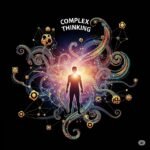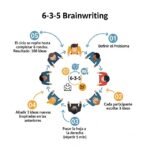
Data Science has become a buzzword in the digital age, but what does it exactly entail? This article aims to demystify the intricate world of data science by breaking down its core concepts and practical applications.
Data scientists, when analyzing satellite images, can predict crop performance with an accuracy of 95% (HSAT), or that every click, scroll, and swipe on your phone tells a story. With vast amounts of data now available, companies in almost every industry are focused on harnessing data to gain a competitive advantage (Provost and Fawcett, 2013a).
Technological advances have enabled the storage of ever-increasing amounts of data. However, this corporate ‘wealth’ is not fully leveraged to derive insights and knowledge about customers, processes, etc.
In recent years, data science has emerged as a new and significant discipline (van der Aalst, 2016) because it allows uncovering trends and generating information for companies to make better decisions and create innovative products and services.
Having a data scientist has become a necessity for companies looking to establish and maintain a competitive edge. In this article, we aim to provide you with a comprehensive overview of data science and its importance in managing data, creating information, and fostering knowledge within your company.
What is Data Science?
As a field, Data Science, or Ciencia de Datos in Spanish, is still relatively new, emerging from the realms of statistical analysis and data mining. The goal of data science is to enhance decision-making by basing decisions on trends extracted from extensive databases (Igual and Seguí, 2017).
Data Science is an interdisciplinary field involving extracting actionable insights from both structured and unstructured data. It combines statistical analysis, mathematics, computer science, and domain expertise to solve complex problems and make data-driven decisions. Essentially, Data Science aims to uncover patterns, relationships, and trends within data to generate valuable insights.
Data Science can be seen as an amalgamation of classical disciplines such as statistics, data mining, databases, distributed systems, artificial intelligence (AI), and data analysis, all coming together to transform abundant data into value for individuals, organizations, and society (van der Aalst, 2016).
The field encompasses a variety of techniques and methodologies, including data collection, data preprocessing, exploratory data analysis, statistical modeling, machine learning, and data visualization. By leveraging these techniques, data scientists can transform raw data into meaningful information that can drive business growth and innovation.
In summary, Data Science is the discipline that turns data into useful knowledge (Ferrero, 2020). In this regard, managing your company’s data will allow you to gain a profound understanding of process performance, customer behavior, the success (or failure) of marketing campaigns, and more.
Importance of Data Science in the Company
Today, Data Science plays a significant role in virtually every aspect of a company’s operations and business strategies because it contributes to data-driven decision-making. Some examples include:
- Providing insights about customers to help companies create stronger marketing campaigns and targeted advertising.
- Customer Relationship: Analyzing customer behavior to manage churn and maximize expected value.
- In companies, it enables the prevention of equipment breakdowns.
- In the financial industry, Data Science is used for credit scoring and trading, and in operations through fraud detection and workforce management.
Medeiros et al., (2020) studied the benefits of Data Science (DS) for organizations and concluded that the main benefits include: support for data analysis and knowledge generation with agility; creating a data-driven culture; improving data quality; facilitating understanding of the business environment, opportunity detection, and organizational performance management.
Data Science vs. Big Data
It’s common for Data Science to be confused with Big Data. Below is a comparative table highlighting key differences between Data Science and Big Data, emphasizing their approaches, objectives, tools, and unique applications. While Data Science focuses on gaining insights from data, Big Data revolves around the efficient management and processing of large and complex datasets. Both play integral roles in the era of data-driven decision-making.
Table. Comparison Table: Data Science vs. Big Data
| Feature | Data Science | Big Data |
|---|---|---|
| Definition | Interdisciplinary field focused on extracting valuable information from data through various processes and algorithms. | Refers to the vast volume of structured and unstructured data that is too complex for traditional data processing applications. |
| Main Focus | Analyzing and interpreting data to extract valuable insights and support decision-making. | Handling, storing, and processing massive datasets that traditional databases cannot efficiently manage. |
| Objective | Discovering patterns, trends, and correlations within data for informed decision-making and predictions. | Managing, processing, and analyzing large-scale datasets efficiently to gain actionable insights. |
| Tools and Techniques | Utilizes statistical analysis, machine learning algorithms, and various programming languages (e.g., Python, R). | Employs distributed computing frameworks (e.g., Hadoop, Spark) and NoSQL databases for efficient storage and processing. |
| Scope | Encompasses a broad spectrum, including data analysis, machine learning, predictive modeling, and visualization. | Primarily deals with the handling and processing of immense datasets, with a focus on scalability and performance. |
| Applications | Applied in various industries such as healthcare, finance, marketing, etc., for data-driven decision-making. | Widely used in scenarios where traditional databases fall short, such as social media analysis, IoT, and real-time data processing. |
| Skill Set | Requires a combination of statistical knowledge, programming skills, domain expertise, and communication skills. | Involves expertise in distributed computing, knowledge of big data technologies, and skills in scalable data storage. |
| Examples | – Predictive maintenance in manufacturing. – Fraud detection in financial transactions. – Personalized recommendations in e-commerce. | – Social media data analysis for sentiment analysis. – Real-time data processing in smart cities. – Genome sequencing in bioinformatics. |
Strategies for Exploring the World Using Data
According to Igual and Seguí (2017), data science enables us to adopt four different strategies for exploring the world using data:
Probing Reality
Data can be collected through passive or active methods. In the latter case, data represents the world’s response to our actions. Analyzing these responses can be extremely valuable when making decisions about our subsequent actions. One of the best examples of this strategy is the use of A/B testing for web development: What is the best size and color for a button? The best answer can only be found by probing the world.
Discovery of Patterns
If we have a dataset of problems, we can automatically analyze them to discover useful patterns and natural groupings that can significantly simplify their solutions. Using this technique to profile users is a critical ingredient today in fields as important as programmatic advertising or digital marketing.
Predicting Future Events
Since the early days of statistics, one of the most important scientific questions has been: How to build robust data models capable of predicting data samples in the future? Predictive analysis allows making decisions in response to future events, not just reactively. For example, predictive analysis can be used to optimize planned tasks for retail store staff in the coming week by analyzing data such as weather, sales history, traffic conditions, etc.
Understanding People and the World
This is an objective that is currently beyond the reach of most companies and individuals, but large corporations and governments are investing considerable amounts of money in research areas such as natural language understanding, computer vision, psychology, and neuroscience. Scientific understanding of these areas is crucial for data science because, ultimately, to make optimal decisions, it is necessary to understand the actual processes that drive people’s decisions and behavior.
Data Science Methodology
How do we work with data? IBM (2020) indicates that the data science lifecycle includes five processes: capture, prepare and maintain, preprocess and process, analyze, and communicate.

Summary of Each Process:
Data Collection and Preprocessing
Data collection is the first step in the data science process, involving the identification and gathering of relevant data from various sources. This may include structured data from databases, unstructured data from social networks, or even data from IoT device sensors. The quality and relevance of collected data are crucial for obtaining accurate and meaningful insights.
After collecting data, the next step is data preprocessing. This involves cleaning, transforming, and normalizing data to make it suitable for analysis. Data preprocessing is essential as it helps eliminate any inconsistencies or errors in the data that could affect the accuracy of derived insights.
Data preprocessing techniques include handling missing values, treating outliers, and scaling the data. Missing values can be imputed using various methods, such as mean imputation or regression imputation. Outliers, data points significantly deviating from the rest, can be detected and either removed or adjusted. Scaling the data ensures that all variables are on a similar scale, which is important for certain machine-learning algorithms.
Exploratory Data Analysis (EDA)
Once data is collected and preprocessed, the next step is Exploratory Data Analysis (EDA). EDA involves visualizing and summarizing data to better understand its characteristics. This helps identify patterns, outliers, and relationships between variables.
During EDA, data scientists use various statistical techniques and data visualization tools to explore the data. They can calculate summary statistics such as mean, median, and standard deviation to describe central trends and distributions of the data. They can also create visualizations like histograms, scatter plots, and box plots to visualize relationships between variables.
EDA plays a crucial role in discovering insights and formulating hypotheses that can guide further analysis. It helps data scientists identify potential data issues, understand the underlying distribution of data, and discover interesting patterns that may not be immediately evident.
Statistical Modeling and Machine Learning
Statistical modeling and machine learning are two key components of data science that enable knowledge extraction from data. Statistical modeling involves using statistical techniques to analyze relationships between variables and make predictions or inferences. Machine learning, on the other hand, focuses on developing algorithms that can learn from data and make predictions or decisions without being explicitly programmed.
Statistical modeling techniques include regression analysis, used to model the relationship between a dependent variable and one or more independent variables. Other techniques include time series analysis, classification, and clustering. These techniques allow data scientists to uncover relationships, make predictions, and gain a deeper understanding of the data.
Machine learning algorithms, on the other hand, can be classified into supervised learning, unsupervised learning, and reinforcement learning.
- Supervised learning involves training a model with labeled data to make predictions or classifications.
- Unsupervised learning aims to identify patterns or groups in unlabeled data.
- Reinforcement learning involves training an agent to make decisions in a dynamic environment based on rewards and punishments.
Data Visualization and Results Presentation
Data visualization is a crucial aspect of data science, helping communicate insights effectively. Visualizations provide a way to represent complex data in a more understandable and intuitive format. They enable data scientists to visually present their findings and tell a compelling story using data.
Several tools and libraries are available for creating data visualizations, such as Tableau, ggplot, and D3.js. These tools allow data scientists to create visually appealing and interactive charts, graphs, and dashboards that can convey complex information in a simplified manner.
Data Presentation
Data presentation involves using visualizations and data narratives to communicate insights and findings to a non-technical audience. It combines data analysis with storytelling techniques to make data more relatable and engaging. By telling a story with data, data scientists can effectively convey the importance and impact of their findings.
Applications of Data Science in Various Industries
Data science has a wide range of applications across all industries, including healthcare, finance, e-commerce, and more.
Healthcare
In healthcare, data science is used to analyze data from genetic markers and patients’ medical records to develop predictive models for the diagnosis and treatment of diseases, even before symptoms appear. Data science also helps optimize hospital operations and resource allocation, as well as the development of new drugs. For instance, Vesoulis et al., (2023) highlight that data science methods provide tools for better clinical, predictive, and preventive practices, as well as defining individual disease risks, mechanisms, and therapies.
Agriculture
Data science is driving the next agricultural revolution. By analyzing soil conditions and weather patterns, farmers can now optimize crop yields and reduce water waste with high precision. An example can be found in the study by Hossen et al., (2022), where they analyzed various data science technologies and their effect on the agricultural perspective in Bangladesh.
Finance
In finance, data science is used for fraud detection, risk analysis, and trading. It enables financial institutions to make data-driven decisions, identify market trends, and manage risks effectively.
Marketing
In marketing, data science is used for personalized sales, recommendation systems, and demand forecasting. Rosário et al., (2021) report that Data Science in marketing has focused on digital advertising, micro-segmentation and micro-targeting, speed and performance, and real-time experimentation.
Other industries such as manufacturing, transportation, and energy also benefit from data science. It helps optimize supply chain operations, predict equipment failures, and improve energy efficiency. The applications of data science are broad and continue to expand as more organizations recognize the value of data-driven decision-making; Sarker (2021) provides a more detailed analysis of Data Science applications in various fields.
Team for Implementing Data Science Processes
The ideal composition of a data science team may vary based on the specific needs of the company and projects, but generally, a well-balanced data science team should include professionals with diverse skills and knowledge. Here is a typical structure for a data science team:
Lead Data Scientist
- Responsible for leading the team and aligning data science projects with business objectives.
- Must have a strong understanding of the company’s strategy and skills to communicate technical results to stakeholders.
Data Analysts
- Tasked with collecting, cleaning, and analyzing data to uncover patterns and trends.
- Should be adept at using data analysis tools and possess solid knowledge in statistics and programming.
Data Engineer
- Handles data infrastructure, collection, and storage.
- Needs skills in software engineering, databases, and large-scale data processing.
Machine Learning Data Scientist
- Specialized in building and deploying machine learning models.
- Should have experience in machine learning algorithms, model optimization, and performance evaluation.
Machine Learning Engineer (ML Engineer)
- Responsible for taking machine learning models into production.
- Must have strong software development skills and a deep understanding of machine learning models.
Business Analyst
- Connects data analysis with business objectives.
- Must understand business needs and translate them into analytical questions for the data science team.
User Experience Designer (UX Designer)
- Collaborates on data visualization and the creation of intuitive interfaces to present analysis results.
- Contributes to the understanding and adoption of data science solutions.
Data Communication Expert
- Responsible for communicating analysis results and insights clearly and effectively to stakeholders.
- Should have skills in data visualization and storytelling.
The key to a successful data science team is collaboration among these diverse roles. The combination of technical, business, and communication skills ensures that the team can address the complex challenges of data science and provide meaningful value to the organization.
Data Science vs. Data Engineering
Although Data Science and Data Engineering share common ground in the data ecosystem, their approaches, objectives, and skill sets are different. While Data Science focuses on extracting insights, modeling, and supporting decision-making, Data Engineering is concerned with the efficient management and processing of data. Both are integral components of a robust data strategy, working collaboratively to unlock the potential of data within an organization.
Comparative Table: Data Science vs. Data Engineering
| Feature | Data Science | Data Engineering |
|---|---|---|
| Approach and Purpose | Focuses on extracting insights from data using statistical analysis, machine learning, and predictive modeling. | Concentrates on the practical application of data collection, storage, and processing, ensuring efficient data flow through systems. |
| Objectives | Aims to discover patterns, trends, and correlations in data to support informed decision-making, predictions, and optimization. | Aims to design, build, test, and maintain architectures (such as data pipelines) enabling reliable flow and storage of large data volumes. |
| Skill Set | Requires skills in statistical analysis, machine learning algorithms, programming languages (e.g., Python, R), and domain expertise. | Requires skills in database design, ETL processes (Extract, Transform, Load), big data technologies (e.g., Hadoop, Spark), and proficiency in languages like SQL. |
| Responsibilities | Involves exploratory data analysis, feature engineering, model development, and interpretation of results for decision-making. | Involves developing data pipelines, managing databases, ensuring data quality, and creating infrastructures for efficient data storage. |
| Results | Produces actionable insights, visualizations, and predictive models contributing to decision-making processes. | Establishes and maintains the necessary infrastructure for reliable data flow and storage, ensuring its availability and accessibility. |
| Temporality | Often focuses on historical and current data for predictions or extracting insights. | Primarily concerned with real-time and batch processing of large data volumes. |
| Lifecycle Phase | More prominent in later stages of the data lifecycle, where attention is on analysis and interpretation. | Plays a crucial role in the early stages of the data lifecycle involving data collection, cleaning, and storage. |
| Tools and Technologies | Utilizes tools like Jupyter notebooks, TensorFlow, scikit-learn for modeling, and visualization tools like Matplotlib and Tableau. | Utilizes tools like Apache Hadoop, Apache Spark, SQL for database management, and ETL tools like Apache NiFi. |
Tools for Data Science
Data scientists use various types of tools, with open-source applications being the most common. Stedman (2021) highlights the use of the following platforms and tools for data science:
- Data platforms and analytics engines, such as Spark, Hadoop, and NoSQL databases.
- Programming languages, including Python, R, Julia, Scala, and SQL.
- Statistical analysis tools like SAS and IBM SPSS.
- Machine learning libraries and platforms, including TensorFlow, Weka, Scikit-learn, Keras, and PyTorch.
- Jupyter Notebook, is a web application for sharing documents with code, equations, and other information.
- Libraries and data visualization tools like Tableau, D3.js, and Matplotlib.
Professional Opportunities in Data Science
As organizations increasingly rely on data to drive decision-making, the demand for data scientists continues to rise. A career in data science offers exciting opportunities for those passionate about analysis and problem-solving.
Data scientists can find employment in various industries, including technology, finance, healthcare, and consulting. They can work as data analysts, data engineers, machine learning engineers, or data science consultants. The field offers competitive salaries, challenging projects, and the opportunity to make a significant impact on businesses and society.
Data Scientist
As a data scientist, you will work on analyzing complex datasets, developing predictive models, and providing insights to drive business decisions. You will collaborate with cross-functional teams and use your analytical skills to solve complex problems.
Data Analyst
Data analysts focus on collecting, cleaning, and analyzing data to provide insights and support decision-making. They work closely with stakeholders to understand business requirements and develop reports and dashboards to visualize data.
Machine Learning Engineer
Machine learning engineers focus on developing and implementing machine learning models in production. They work closely with data scientists to deploy and optimize algorithms, as well as manage the infrastructure required for model implementation.
Data Engineer
Data engineers are responsible for building and maintaining the infrastructure necessary for data storage, processing, and analysis. They work with large-scale data systems, such as data warehouses and data lakes, ensuring the quality and integrity of the data.
Business Analyst
Business analysts bridge the gap between data science and business stakeholders. They work closely with both technical and non-technical teams to define business requirements, identify improvement opportunities, and drive data-driven decision-making.
These are just some examples of the professional careers available in data science. The field is constantly evolving, with new roles and opportunities emerging.
To pursue a career in data science, individuals should acquire a strong foundation in statistics, mathematics, and computer science. They should also develop skills in programming, data analysis, and machine learning. Continuous learning and staying updated with the latest tools and techniques are essential for success in this dynamic field.
Conclusion
Data science is a rapidly evolving field that combines statistics, mathematics, and computer science to extract insights from data. It involves various techniques and methodologies, including data collection, preprocessing, exploratory data analysis, statistical modeling, and machine learning. Data scientists leverage these techniques to discover patterns, make predictions, and drive informed decision-making.
Data science has applications in all industries and plays a crucial role in enabling organizations to gain a competitive advantage. By harnessing the power of data, companies can optimize their operations, enhance customer experiences, and drive innovation. However, challenges persist, including the development of a data-driven culture, data science training, allocation of investments in analytical technologies, and data governance and strategy (Medeiros et al., 2020).
References
Ferrero, R. 2020. Qué es la ciencia de datos. Maxima Formación.
Hossen, M. H., Hasan, M. M., Sajidul, I. K., & Hu, W. (2022, January). Digital Revolution in the Agriculture Based on Data Science. In 2022 2nd Asia Conference on Information Engineering (ACIE) (pp. 6-12). IEEE.
IBM Cloud Education. 2020. Data Science. IBM.
Igual L., Seguí S. (2017) Introduction to Data Science. In: Introduction to Data Science. Undergraduate Topics in Computer Science. Springer, Cham.
Kelleher J. and B. Tierney. 2018. Data Science. The MIT Press Essential Knowledge Series.
Liu A. 2015. Data Science and Data Scientist. IBM Analytics. 11 p.
Medeiros, M. M. D., Hoppen, N., & Maçada, A. C. G. (2020). Data science for business: Benefits, challenges and opportunities. The Bottom Line, 33(2), 149-163.
Provost F. and T. Fawcett. 2013a. Data Science for Business: What You Need to Know about Data Mining and Data-Analytic Thinking.
Provost F. and T. Fawcett. 2013b. Data Science and its Relationship to Big Data and Data-Driven Decision Making. Big DataVol. 1, No. 1 https://doi.org/10.1089/big.2013.1508
Rosário, A., Moniz, L. B., & Cruz, R. (2021). Data science applied to marketing. Journal of Information Science and Engineering, 37(5), 1067-1081.
Sarker, I. H. (2021). Data science and analytics: an overview from data-driven smart computing, decision-making and applications perspective. SN Computer Science, 2(5), 377.
Stedman C. 2021. Ciencia de datos. Computer Weekly.
van der Aalst W. (2016) Data Science in Action. In: Process Mining. Springer, Berlin, Heidelberg. https://doi.org/10.1007/978-3-662-49851-4_1
Vesoulis, Z. A., Husain, A. N., & Cole, F. S. (2023). Improving child health through Big Data and data science. Pediatric research, 93(2), 342-349.
Editor and founder of “Innovar o Morir” (‘Innovate or Die’). Milthon holds a Master’s degree in Science and Innovation Management from the Polytechnic University of Valencia, with postgraduate diplomas in Business Innovation (UPV) and Market-Oriented Innovation Management (UPCH-Universitat Leipzig). He has practical experience in innovation management, having led the Fisheries Innovation Unit of the National Program for Innovation in Fisheries and Aquaculture (PNIPA) and worked as a consultant on open innovation diagnostics and technology watch. He firmly believes in the power of innovation and creativity as drivers of change and development.





